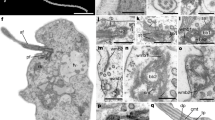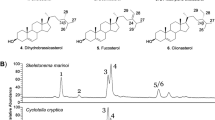Abstract
AMONG eukaryotes, α-linolenic acid (18 : 3α) and certain related polyunsaturated fatty acids occur as major fatty acids only in photosynthetic organisms1, where they are concentrated in chloroplasts as components of the acyl lipids2. Photosynthetic bacteria, by contrast contain saturated and monounsaturated fatty acids exclusively, a character which they share with nearly all non-photosynthetic bacteria3–5. Blue–green algae are the only prokaryotes which photosynthesize as do green plants, and their fatty acid composition is thus of particular interest from the evolutionary standpoint. Many filamentous blueαgreen algae have been shown to contain polyunsaturated fatty acids6,8,9, but these compounds are absent from three unicellular blue–green algae so far examined: Anacystis nidulans, Anacystis marina and Synechococcus cedrorum6,7,9. This has prompted us to undertake a more extensive survey of the fatty acid composition of blue–green algae, with particular attention to unicellular representatives.
This is a preview of subscription content, access via your institution
Access options
Subscribe to this journal
Receive 51 print issues and online access
$199.00 per year
only $3.90 per issue
Buy this article
- Purchase on Springer Link
- Instant access to full article PDF
Prices may be subject to local taxes which are calculated during checkout
Similar content being viewed by others
References
Korn, E. D., J. Lipid Res., 5, 352 (1964).
Benson, A. A., Ann. Rev. Plant Physiol., 15, 1 (1964).
Kates, M., Adv. Lipid Res., 2, 17 (1964).
Wood, J. B., Nichols, B. W., and James, A. T., Biochim. Biophys. Acta, 106, 261 (1965).
Constantopoulos, G., and Bloch, K., J. Bact., 93, 1788 (1967).
Holton, R. W., Blecker, H. H., and Stevens, T. S., Science, 160, 545 (1968).
Nichols, B. W., Harris, R. V., and James, A. T., Biochem. Biophys. Res. Commun., 20, 256 (1965).
Nichols, B. W., and Wood, J. B., Lipids, 3, 46 (1968).
Parker, P. L., van Baalen, C., and Maurer, L., Science, 155, 707 (1967).
Purnell, H., Gas Chromatography (Wiley, New York, 1962).
Brian, B. L., and Gardner, E. W., Appl. Microbiol., 16, 549 (1968).
Scheuerbrandt, G., and Bloch, K., J. Biol. Chem., 237, 2064 (1962).
Cruden, D. L., and Stanier, R. Y., Arch. Mikrobiol., 72, 115 (1970).
Levin, E., Lennarz, W. J., and Bloch, K., Biochim. Biophys. Acta, 84, 471 (1964).
Erwin, J., and Bloch, K., Biochem. Z., 338, 496 (1963).
Author information
Authors and Affiliations
Rights and permissions
About this article
Cite this article
KENYON, C., STANIER, R. Possible Evolutionary Significance of Polyunsaturated Fatty Acids in Blue–Green Algae. Nature 227, 1164–1166 (1970). https://doi.org/10.1038/2271164a0
Received:
Issue Date:
DOI: https://doi.org/10.1038/2271164a0
This article is cited by
-
Fatty acid profiles and their distribution patterns in microalgae: a comprehensive analysis of more than 2000 strains from the SAG culture collection
BMC Plant Biology (2011)
-
Effects of season and reproductive state on lipid intake and fatty acid composition of gastrointestinal tract contents in the European hare
Journal of Comparative Physiology B (2011)
-
Changes in the antenna size of Photosystem I and Photosystem II in Synechococcus sp. strain PCC 7942 grown in the presence of SANDOZ 9785 ? a Photosystem II inhibitor
Photosynthesis Research (1994)
-
Optimization of γ-linolenic acid (GLA) production inSpirulina platensis
Journal of Applied Phycology (1994)
-
Total fatty acid composition as a taxonomic index of some marine microalgae used as food in marine aquaculture
Hydrobiologia (1990)
Comments
By submitting a comment you agree to abide by our Terms and Community Guidelines. If you find something abusive or that does not comply with our terms or guidelines please flag it as inappropriate.



